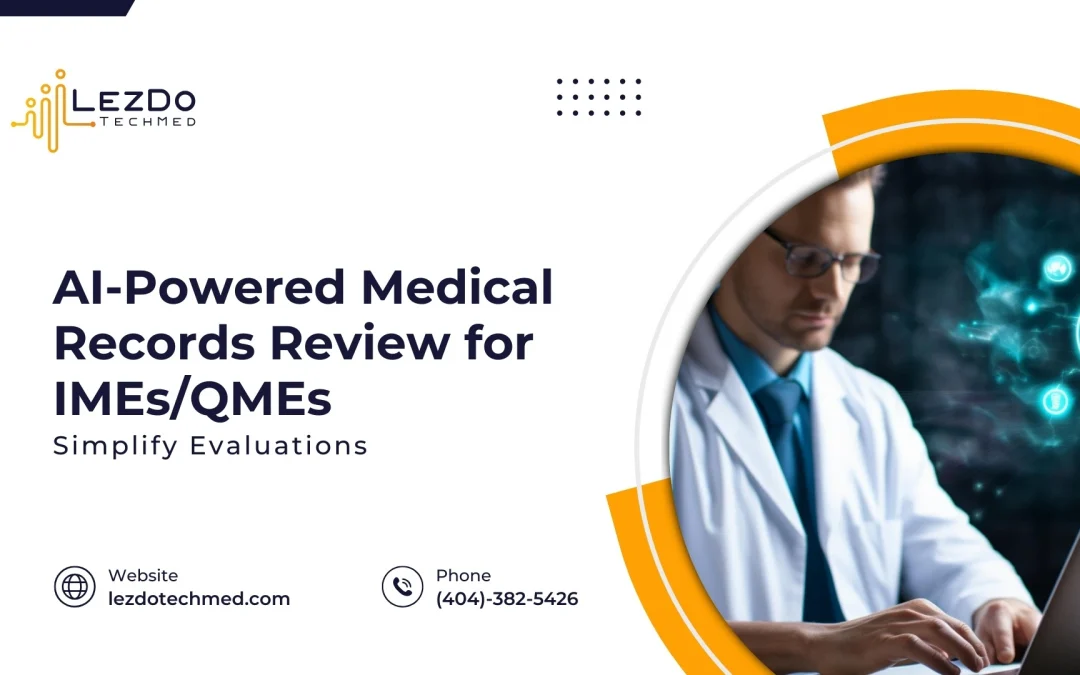Understanding medical terminologies is crucial for legal professionals, especially those who handle personal injury, medical malpractice and insurance claims. Legal people without medical background find it difficult to grasp the complicated medical jargon. Without understanding them, lawyers cannot quantify the damages or comprehend the severity of such medical conditions. Moreover, misconceptions in grasping vital facts can impact even the course of the legal claims.
Through this blog, we try to help legal professionals discover how to decode the most complex medical terminologies.
How to Translate Medical Terminologies in Medical Records?
Do you know what are the steps to decoding a medial term? Know the key strategies here.
1. Understand the Basics
Medical terms or medical terminology is a special language used to precisely describe the human body, its functions, diseases, injuries, procedures and treatments. These terms are made of root words, prefixes and suffixes, mostly derived from Latin and Greek. Let’s see a few examples here and find out – which of the following is needed to help decode a medical term?
Root words: The main part of the term, usually indicating a body part or system (Eg., “cardi” means heart).
Prefixes: Added to the beginning of the root word to modify its meaning (e.g., “brady” meaning slow, as in “bradycardia” – slow heart rate).
Suffixes: Added to the end of the root word, often indicating a procedure, condition, or disease (e.g., “-itis” meaning inflammation, as in “arthritis” – inflammation of the joints).
2. Know the Key Medical Terminologies and Meanings
Let’s see some important medical terminologies and their components to help you understand their meanings.
Cardiomegaly: “Cardio” (heart) + “megaly” (enlargement) = enlargement of the heart.
Gastroenterology: “Gastro” (stomach) + “entero” (intestines) + “logy” (study of) = study of the stomach and intestines.
Neuropathy: “Neuro” (nerve) + “pathy” (disease) = disease of the nerves.
Hematology: “Hema” (blood) + “logy” (study of) = study of blood.
Let’s see more medical terms related to orthopedic and neurological conditions and know what they mean here:
Orthopedic Conditions
- Achilles Tendonitis: Inflamed heel tendon
- Bursitis: Inflammation of joint sacs
- Carpal Tunnel Syndrome: Wrist nerve compression
- Cervical Spondylosis: Neck arthritis
- Compartment Syndrome: Muscle pressure buildup
- Dislocation: Joint out of place
- Dupuytren’s Contracture: Hand deformity
- Epicondylitis (Tennis Elbow): Elbow tendon inflammation
- Herniated Disc (Slipped Disc): Displaced spinal disc/ disc bulge
- Ligamentous Laxity: Loose ligaments
- Lumbar Spondylosis: Lower back arthritis
- Osteoarthritis: Joint wear and tear
- Osteoclast – type of bone cell that breaks down bone tissue to be reshaped into stronger one
- Osteomyelitis: Bone infection
- Patellofemoral Pain Syndrome: Knee pain
- Plantar Fasciitis: Heel pain
- Rheumatoid Arthritis: Joint inflammation
- Rotator Cuff Tear: Torn shoulder tendons
- Scoliosis: Curved spine
- Sprain: Torn ligament
- Strain: Torn muscle or tendon
- Tendonitis: Tendon inflammation
- Torn Meniscus: Torn knee cartilage
- Whiplash: Neck injury
Neurological Conditions
- Amyotrophic Lateral Sclerosis (ALS): Nerve degeneration
- Anoxic Brain Injury: Brain damage from lack of oxygen
- Arteriosclerosis- a disease where arteries become damaged due to high blood pressure, high cholesterol or diabetes.
- Bell’s Palsy: Facial paralysis
- Cerebral Contusion: Brain bruise
- Cerebrovascular Accident (CVA): Stroke
- Chronic Traumatic Encephalopathy (CTE): Repeated head injury brain damage
- Cluster Headaches: Severe recurring headaches
- Concussion: Mild brain injury
- Encephalopathy: Brain disease
- Epilepsy: Seizure disorder
- Guillain-Barré Syndrome: Nerve disorder
- Hydrocephalus: Brain fluid buildup
- Migraine: Severe headache
- Multiple Sclerosis (MS): Nerve disease
- Myasthenia Gravis: Muscle weakness
- Neuralgia: Nerve pain
- Nerve Compression (Pinched Nerve): Nerve pressure
- Parkinson’s Disease: Movement disorder
- Peripheral Neuropathy: Nerve damage
- Radiculopathy: Nerve root compression
- Sciatica: Lower back nerve pain
- Spinal Cord Injury: Spinal damage
- Subdural Hematoma: Brain blood clot
- Transient Ischemic Attack (TIA): Mini-stroke
- Traumatic Brain Injury (TBI): Severe and complicated brain injury
3. Identify Common Prefixes and Suffixes Used with Medical Terms
Having a basic understanding of the prefixes and suffixes that come along with the terms itself can help you grasp the meaning of the terms. Here, let’s decode some of the prefixes and suffixes.
Prefixes:
A- / An-: Without, lack of (e.g., aplasia – lack of development of an organ)
Auto-: Self (e.g., autoimmune – immune response against the body’s own tissues)
Bio-: Life (e.g., biology – study of life)
Brady-: Slow (e.g., bradycardia – slow heart rate)
Dys-: Difficult, painful, abnormal (e.g., dysphagia – difficulty swallowing)
Hemo- / Hemato-: Blood (e.g., hematology – study of blood)
Hetero-: Different (e.g., heterogeneous – composed of different substances)
Homo-: Same (e.g., homogeneous – composed of the same substances)
Hyper-: Above normal (e.g., hypertension – high blood pressure)
Hypo-: Below normal (e.g., hypoglycemia – low blood sugar)
Inter-: Between (e.g., intermuscular – between the muscles)
Intra-: Within (e.g., intravenous – within the veins)
Macro-: Large (e.g., macrocyte – large cell)
Micro-: Small (e.g., microscope – instrument to view small objects)
Neo-: New (e.g., neonatal – pertaining to newborns)
Oligo-: Few, scanty (e.g., oliguria – scanty urine output)
Peri-: Around (e.g., pericardium – membrane around the heart)
Poly-: Many (e.g., polyuria – excessive urination)
Post-: After (e.g., postoperative – after surgery)
Pre-: Before (e.g., prenatal – before birth)
Sub-: Under, below (e.g., subcutaneous – under the skin)
Tachy-: Fast (e.g., tachycardia – fast heart rate)
Trans-: Across, through (e.g., transfusion – transfer of blood)
Uni-: One (e.g., unilateral – one-sided)
Suffixes:
-algia: Pain (e.g., neuralgia – nerve pain)
-cele: Hernia, swelling (e.g., cystocele – bladder hernia)
-centesis: Surgical puncture (e.g., amniocentesis – puncture to remove amniotic fluid)
-cyte: Cell (e.g., lymphocyte – immune cell)
-dynia: Pain (e.g., pleurodynia – pain in the pleura)
-ectomy: Surgical removal (e.g., tonsillectomy – removal of the tonsils)
-emia: Blood condition (e.g., leukemia – blood cancer)
-genesis: Formation, production (e.g., osteogenesis – formation of bone)
-gram: Record or picture (e.g., electrocardiogram – record of heart’s electrical activity)
-graph: Instrument for recording (e.g., electrocardiograph – instrument for recording the heart’s activity)
-graphy: Process of recording (e.g., mammography – process of recording images of the breast)
-iasis: Abnormal condition (e.g., cholelithiasis – condition of gallstones)
-itis: Inflammation (e.g., Conjunctivitis – inflammation of the conjunctiva)
-logist: Specialist in the study of (e.g., cardiologist – heart specialist)
-lysis: Breakdown, destruction (e.g., hemolysis – destruction of red blood cells)
-malacia: Softening (e.g., osteomalacia – softening of bones)
-megaly: Enlargement (e.g., hepatomegaly – enlargement of the liver)
-ology: Study of (e.g., dermatology – study of the skin)
-oma: Tumor, mass (e.g., carcinoma – cancerous tumor)
-opsy: View of (e.g., biopsy – view of living tissue)
-ostomy: Creation of an opening (e.g., colostomy – creation of an opening in the colon)
-otomy: Cutting into (e.g., tracheotomy – cutting into the trachea)
-pathy: Disease (e.g., neuropathy – nerve disease)
-plasia: Development, formation (e.g., cervical dysplasia – excessive formation of cells around cervix)
-plasty: Surgical repair (e.g., angioplasty – surgical repair of the blocked blood vessel)
-plegia: Paralysis (e.g., paraplegia – paralysis of both legs)
-rrhea: Flow, discharge (e.g., diarrhea – flow of loose stools)
-sclerosis: Hardening (e.g., arteriosclerosis – hardening of the arteries)
-scope: Instrument for viewing (e.g., endoscope – instrument for viewing inside the body)
-scopy: Process of viewing (e.g., colonoscopy – process of viewing the colon)
-stasis: Stopping, controlling (e.g., hemostasis – stopping of bleeding)
-tomy: Incision, cutting into (e.g., lobotomy – incision into the brain to sever brain pathways)
-trophy: Development, nourishment (e.g., hypertrophy – excessive development, Nephrohypertrophy -excessive development of the kidney)
-uria: Urine condition (e.g., hematuria – presence of blood in urine)
4. Grasp the Contextual Clues
Medical records often provide context that can help decode terms. Look for descriptions of symptoms, diagnoses, and treatments that can clarify the meaning of unfamiliar terms. A comprehensive picture of the patient’s condition from the descriptions can help understand intricate medical terms. For example, if “tachycardia” is mentioned, contextual clues such as heart rate measurements, episodes of rapid heartbeat, and related cardiovascular assessments can help you elucidate the term.
5. Understand Diagnostic Tests and Procedures
Familiarize yourself with common diagnostic tests and surgical procedures to better understand medical records. You can even utilize medical dictionaries, glossaries and online resources like MedlinePlus, WebMed, and the National Institutes of Health (NIH) for accurate definitions and explanations.
Here, we provide you with some of the significant diagnostic tests and procedures for your understanding.
- Abdominoplasty – Tummy tuck
- Adrenalectomy – Removal of one or both adrenal glands
- Amniocentesis – A test done by taking amniotic fluid from womb to check the health of the fetus
- Angioplasty – Balloon surgery to repair blocked blood vessels
- Appendectomy – Appendix removal surgery
- Arthroplasty – Joint replacement surgery
- Bronchoscopy – Examination of the airways
- Cardioversion – A procedure used to restore heart’s normal rhythm
- Carotid Endarterectomy – Surgical procedure to clear plaque from the carotid artery
- Cholecystectomy – Gallbladder removal surgery
- Colonoscopy – Examination of the colon
- Coronary Artery Bypass Graft (CABG) – Procedure to create a bypass around blocked arteries
- Cranioplasty – Repair of a defect in the skull
- Craniotomy – Brain surgery
- Cystectomy – Removal of the bladder
- Endarterectomy- procedure to remove blocks from arteries
- Endoscopy – Using a surgical camera to examine the interior of an organ
- Esophagectomy – Removing the part or entire esophagus
- Extracorporeal Membrane Oxygenation (ECMO) – Machine that supports heart and lung function
- Femoral Popliteal Bypass – Surgery to bypass blocked leg artery
- Fundoplication – Surgery to treat acid reflux (GERD)
- Gastric Bypass – Weight loss surgery that changes the stomach and small intestine
- Gastrectomy – Stomach removal surgery
- Hematopoietic Stem Cell Transplant (HSCT) – Bone marrow transplant
- Hemorrhoidectomy – Removal of hemorrhoids
- Hysterectomy – Uterus removal surgery
- Kyphoplasty – Procedure to treat spinal compression fractures
- Laminectomy – Spinal decompression surgery
- Laparoscopy – Keyhole surgery
- Liver Transplantation – Transplantation of a healthy liver to replace a diseased one
- Mastectomy – Breast removal surgery
- Myomectomy – Removal of uterine fibroids
- Nephrectomy – Kidney removal surgery
- Oophorectomy – Ovary removal surgery
- Pancreatectomy – Removal of part or the whole pancreas
- Percutaneous Coronary Intervention (PCI) – Angioplasty with stent
- Phlebotomy – Blood draw or venipuncture
- Pneumonectomy – Removal of a lung
- Retrograde Pyelogram – X-ray of the urinary system
- Rhinoplasty – Nose job
- Splenectomy – Removal of the spleen
- Strabismus Surgery – Eye muscle surgery to correct the alignment of the eyes
- Thyroidectomy – Thyroid removal surgery
- Tonsillectomy – Tonsil removal surgery
- Tracheostomy – Creating an opening in the neck to place a tube into a person’s windpipe
- Vitrectomy – Removal of the vitreous gel from the eye
6. Consult with Medical Experts
If all the above-discussed techniques couldn’t clarify your doubts, consult medical experts like physicians, registered nurses or other medical consultants. They can provide valuable insights on the complex medical terminologies and clarify the ambiguities in medical terms. Even reviewing the medical documents prepared by various experts continuously can also enlighten your medical knowledge.
7. Reach out to Medical Record Review Services
Medical record review services have special crew of medical experts in all specialty fields to ensure accuracy in medical record reviews. Outsourcing your medical records to experienced record review providers can ease your burden. They will plow out the significant data from medical records and present the complicated medical terminologies in simple terms.
LezDo TechMed has medical experts from all significant medical fields with vast experience in handling complicated medical records. Contact them to convert your intricate medical records into review reports summarized in simple terms.
Want to simplify your complex medical records?
Wrap up
Decoding medical terminologies is a valuable skill for legal professionals handling medico-legal claims. A strong knowledge in medical terms can help you build valid arguments and improve case outcomes. By understanding the structure of the medical terms, using available resources, consulting with experts and training, you can easily grasp the complex medical terminologies in plaintiff’s medical records.
Too busy to analyze the medical terminologies? No worries! LezDo TechMed is there to help you. Contact us and speed up your legal procedures without pressure.
To get more valuable insights on medical terminologies, keep in touch with us! We are here to enlighten you!
Ready to get started? Get free trial worth $500. Hurry up!











